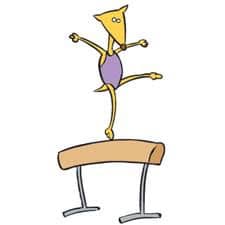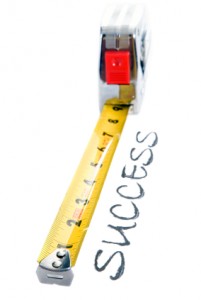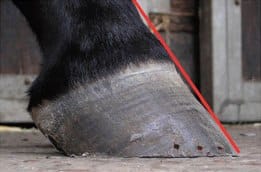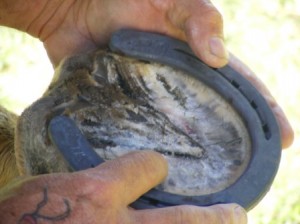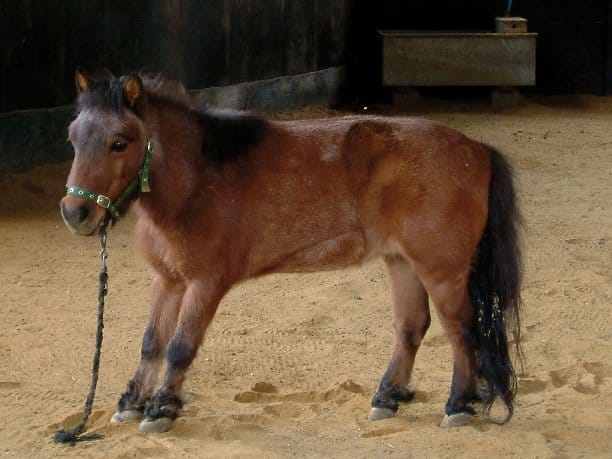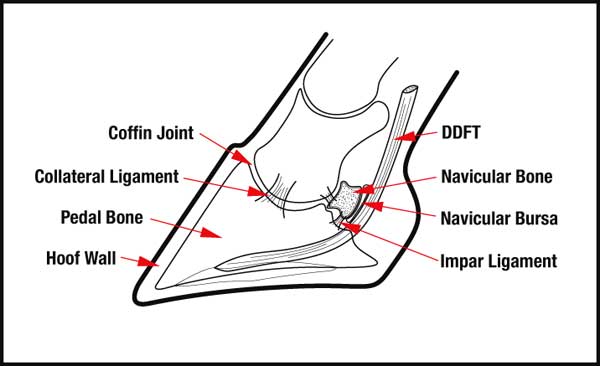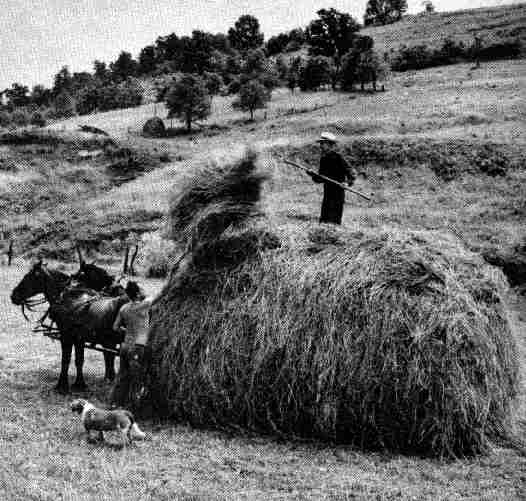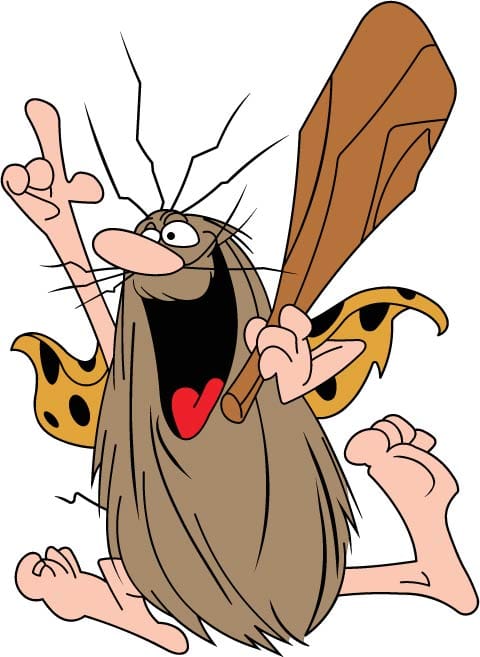I don’t think that any area of the horse gets as much attention as the hoof. With well-intentioned regularity, the horse’s hoof gets picked, oiled, conditioned, supplemented, trimmed, and shod. And, that’s not to mention soaked, wrapped, and placed in any number of boots. And, given the importance of the hoof, to a certain extent, that’s how it should be. Your horse’s hooves deserve a good bit of attention.
 Of course, when it comes to hooves – as with most everything else – just about everyone has an opinion. The problem is, the hoof is right out there for everyone to see. Thus, there’s nothing at all to prevent folks from their opinion about your horses’ hooves (of course, you would never do anything like that). So, depending on who you’re talking to, your horse’s hooves may be too long, too short, too dry, too flaky, too moist, thin-walled, out-of-balance (front to back or side to side), low-heeled, long-toed, shod, barefoot, or unnatural. These are just a few of any number of possible calamities.
Of course, when it comes to hooves – as with most everything else – just about everyone has an opinion. The problem is, the hoof is right out there for everyone to see. Thus, there’s nothing at all to prevent folks from their opinion about your horses’ hooves (of course, you would never do anything like that). So, depending on who you’re talking to, your horse’s hooves may be too long, too short, too dry, too flaky, too moist, thin-walled, out-of-balance (front to back or side to side), low-heeled, long-toed, shod, barefoot, or unnatural. These are just a few of any number of possible calamities.
In one page, it is impossible to take on all of the perceptions, misconceptions, truths, and misinformation that’s out there about horse hooves. So I’m not going to try. But I am going to mention a few things about trimming and shoeing that are true, no matter what. If, in spite of everything else, you can manage to get these things done, you’ve got a decent chance of avoiding major hoof problems with your horse.
I can’t help you with the unsolicited observations, however.
So here goes.
1. Make sure your horse’s hooves are long enough. Inside the hoof are a lot of important, and very sensitive structures. These structures need protection; that protection is the hoof. Your horse has to have a certain amount of hoof in order to keep the tendons, ligaments, bones, and other soft tissues from becoming bruised and battered.
Think of it this way. Your feet are soft and sensitive. To protect them, you wear shoes. To do the same thing for their soft and sensitive parts as shoes do for you, horses grow hooves. If you run around on soft, grassy ground, you can most likely cavort happily in your bare feet, as long as you don’t step on a bee, or something. Try the same amount of cavorting on an asphalt basketball court, and don’t be surprised if your feet hurt in the morning. Ditto your horse, and if he can play basketball, you’ve really got something. But if your horse’s hooves are constantly being trimmed too short, pretty soon, his feet are going to hurt.
Here’s a chart. Read it like this…. “If my horse weighs (fill in the weight, in pounds or kilograms), then his toe should never be shorter than (the length provided in a measuring system of your preference).”
| Horse Weight | Toe length | |||||||
| Horse Size | Kg | Pounds | Cm | Inches | ||||
| Small | 360 – 400 | 800 – 900 | 7.6 | 3.0 | ||||
| Medium | 425 – 475 | 950 – 1050 | 8.25 | 3.25 | ||||
| Large | 525 – 575 | 1150 – 1250 | 8.9 | 3.5 |
And how do you do this? A little tape measure. I have one that I keep on my key chain. Buy one. Measure your horse’s hooves from the hairline to the toe. Make your farrier measure your horse’s hooves from the hairline to the toe when he trims. Don’t have your horse’s feet cut too short. It’ll save you both a lot of pain.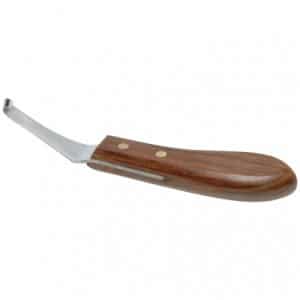
2. Make sure there is adequate sole depth. Even if your horse’s hooves are long enough, there has to be a certain amount of hoof material in the sole to protect those sensitive structures. So, see if you can tactfully ask your farrier to avoid scooping out large amounts of sole with his or her hoof knife. Instead, offer them a nice, stiff metal brush to remove the loose sole that is shedding off between trimmings.
3. Trim to the angle that’s appropriate for your horse. Every horse needs to be trimmed in a manner that’s appropriate for him; there’s no manner that’s appropriate for every horse. You used to read things like the “proper” angle for front and back feet; turns out that the old standards were just plain wrong, because they didn’t consider the individual horse. Guidelines such as 48-55° for the front feet, or 52-60° for the rear feet are not appropriate for every horse.
Instead, think of a straight line running down the front of your horse’s pastern, to the ground (this is called the hoof-pastern axis). If you can get your horse looking like this picture, you’re at least part of the way home. Even at that, you can’t get all horses to look like perfect, and many of them are just fine.
Remember, you’re going to have to ride the horse you have. You can’t ride the pretty picture of what someone else thinks he ought to look like.
4. Use a big enough shoe that’s fit appropriately. While the analogy is not strictly the same, the fact is that a shoe that’s appropriately fit to your horse (assuming you decide to keep him in shoes) is important. You wouldn’t be very happy if you had to run around in a pair of shoes that was a couple of sizes too small, Don’t do the same thing to your horse. And keep in mind that “appropriate” is an individual thing.
In general, I like to try to get the farriers that I work with to fit a horse with the biggest shoe that the horse can practically wear. Obviously, there’s a limit to this, but I think it’s a good idea that the shoe be the largest size as is practicable, to give as big a base as possible. In addition, I think that the branches of the shoe should be placed as far back as possible, without being so far back that the horse steps on them and pulls the shoe off. But that’s just me.
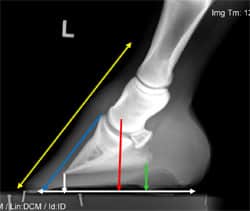
Look for the following: 1) Proper hoof-pastern alignment (yellow line); 2) Parallel alignment between the hoof and bone (blue line); 3) Adequate sole depth (yellow and green lines); 4) Proper shoe placement (white line). The red line indicates the center of rotation of the joint of the foot (the coffin joint).
Hey, let’s look at if from the inside! Here’s an X-ray that gives you an idea of how a horse’s hoof should look when it’s been well-trimmed and had a shoe placed on it appropriately. The hoof-pastern axis is a straight (yellow) line, there’s adequate depth of the sole (little white line), the foot looks to be long enough (even though we can’t measure it). No guarantees, of course, but this looks like a good set-up for a horse to go sound, and stay sound.
Now, obviously, there’s a whole lot more to it than that. If you’re really interested in getting in depth, check out these articles, from my friend Dr. Steve O’Grady’s website –
GUIDELINES FOR TRIMMING THE EQUINE FOOT: A REVIEW
PROPER PHYSIOLOGICAL HORSESHOEING: WHAT IS IT? HOW DO WE APPLY IT?
PHYSIOLOGICAL HORSESHOEING: AN OVERVIEW
Now there’s one final thing that I want you to keep in mind. If your horse is moving well, and isn’t having lameness problems, it’s probably because things are going pretty well. The way to screw up a good relationship is to constantly pick on it (come to think about it, those are probably good words to live by in a lot of areas). Maybe the most important thing, when it comes to taking care of your horse’s hooves, is to set up a good relationship with your veterinarian and your farrier, and keep an open line of communications among everybody. If you’ve got that going for you, and your horse is going well, you’re way ahead of the game!

